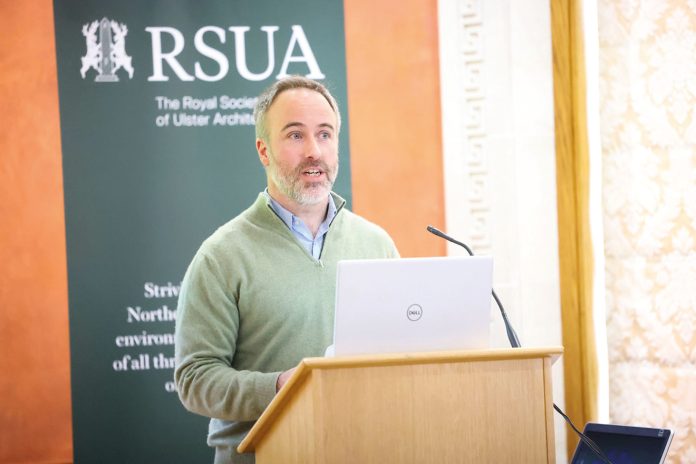At the beginning of the year, the architects of Northern Ireland set out a series of necessary changes to Northern Ireland’s built environment to help reduce greenhouse gas emissions in line with targets set in the Climate Change Act (NI) 2022. The Climate Action Paper was launched at Stormont by the Royal Society of Ulster Architects (RSUA) and contains 39 key actions suggested for existing and new buildings, building materials, heat and power, green initiatives and more sustainable alternatives for travel.
“The paper’s approach was not to be preachy or point fingers, but to identify the actions that can be taken by government departments and people who have the power to change the legislation to lower carbon emissions,” commented architect Alan Ritchie, Director at C60 Architects and Chair of the Chair RSUA Climate Emergency Committee. “Most estimates suggest that the built environment accounts for approximately 40% of energy-related carbon emissions, and the RSUA recognises that the journey to net zero for Northern Ireland will require a radical transformation not only of our sector, but of economy and society as a whole, as the sectors are all connected, and changes can have a ripple effect. It is all about a holistic view.”
In this interview to NI Builder Magazine, Alan explains how these initiatives can help radically reduce everyone’s contribution to climate change and make Northern Ireland more appealing for investment.
NIB: Why does the Climate Change Paper include sections on alternatives to motor vehicles, planting of native species of trees and other calls to action that are not directly related to the building sector?
AR: We proposed changes to other sectors as well because it is not only about building methods and regulations. As architects, we design that part of our environment, but to have a greener environment as a whole, we need to think about sustainable wood and other materials, about making space for nature in every project where feasible, about changes in the infrastructure to improve existing and incentivise new green transport options. It is a matter of connecting all these dots and keeping the balance in living environments. This holistic view also helps bring society together.
NIB: How has the paper been received?
AR: Reaction has been really good. We made a point to launch it at Stormont, in a kind of a symbolic gesture to say that we were at the centre of political change even though the people that should be there making the changes weren’t. Subsequently, I have been asked to present the paper on numerous different forums, such as NI Builder’s BUILDEX Belfast, but also at universities and real estate firms. People have found it interesting because the paper addresses the people who can actually make the changes and gives them the opportunity to take these calls to action on board, to include them in their own action plan.
NIB: Is there a will for change in Northern Ireland?
AR: The government departments certainly feel the pressure from the commercial sector. Large corporations have an agenda to lessen their impact on the environment, so they need to rent buildings that are green and environmentally friendly, for example. They can’t be seen to be working out of a bad building. Developers should also be able to borrow money more easily if their buildings are going to be greener. Normally legislation leads the change, but the commercial development sector is now demanding it; they want green buildings because they can rent them to the top corporations of the world.
Belfast would benefit greatly from having Grade A buildings as a standard, for example. The city is interlinked with Europe and other parts of the UK and offers a great pool of knowledge and expertise. A green ethos would tick another big box for big corporations to invest here.
NIB: What does the RSUA Climate Emergency Committee anticipate for the near future?
AR: The paper has been published, but we need to keep pushing these calls to action. If we don’t start moving right now, the targets established by the Climate Change Act (NI) 2022 won’t be met. There is quite a lot to do between now and 2030. Building regulations are certainly going to change again as the sector will see our building envelopes perform better and better. By 2030, we will hopefully see a building standard that technically won’t need retrofitting in the future.
However, the RSUA recognises this is a long-term strategy, and hopes this paper will assist in the development of plans to achieve the 2030 target and ultimately net zero by 2050.








